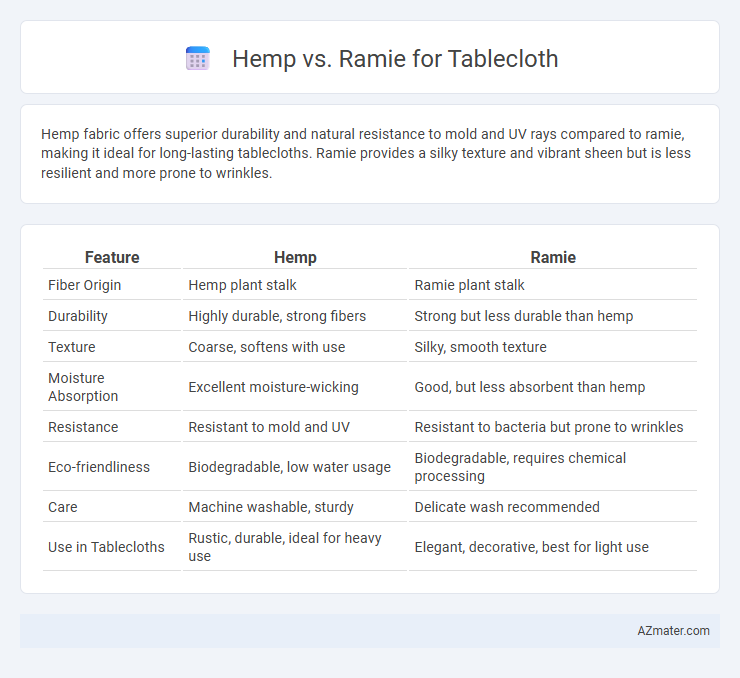Hemp fabric offers superior durability and natural resistance to mold and UV rays compared to ramie, making it ideal for long-lasting tablecloths. Ramie provides a silky texture and vibrant sheen but is less resilient and more prone to wrinkles.
Table of Comparison
| Feature | Hemp | Ramie |
|---|---|---|
| Fiber Origin | Hemp plant stalk | Ramie plant stalk |
| Durability | Highly durable, strong fibers | Strong but less durable than hemp |
| Texture | Coarse, softens with use | Silky, smooth texture |
| Moisture Absorption | Excellent moisture-wicking | Good, but less absorbent than hemp |
| Resistance | Resistant to mold and UV | Resistant to bacteria but prone to wrinkles |
| Eco-friendliness | Biodegradable, low water usage | Biodegradable, requires chemical processing |
| Care | Machine washable, sturdy | Delicate wash recommended |
| Use in Tablecloths | Rustic, durable, ideal for heavy use | Elegant, decorative, best for light use |
Introduction: Hemp vs Ramie Tablecloths
Hemp and ramie fibers are both known for their durability and eco-friendly qualities, making them popular choices for tablecloths. Hemp tablecloths offer natural resistance to stains and mildew, while ramie provides a silky texture and vibrant sheen that enhances table aesthetics. Comparing hemp and ramie tablecloths highlights the balance between strength and elegance, perfect for sustainable home decor.
Fiber Origins and Historical Uses
Hemp fiber originates from the stalk of the Cannabis sativa plant, known for its durability and resistance to pests, with cultivation dating back over 10,000 years in ancient Asia for textiles and ropes. Ramie fiber, derived from the stalks of the Boehmeria nivea plant, has been used for centuries in East Asia, particularly China, valued for its silky luster and ability to hold shape even without chemical treatments. Both fibers have historical significance in fabric production, but hemp's coarse texture contrasts with ramie's finer, silk-like quality, influencing their traditional applications in tablecloth weaving and household textiles.
Environmental Impact and Sustainability
Hemp tablecloths offer superior environmental benefits due to their fast growth rate, low water consumption, and natural resistance to pests, reducing the need for harmful pesticides. Ramie, while also biodegradable and requiring fewer pesticides than cotton, demands intensive processing to soften its fibers, increasing its environmental footprint. Choosing hemp promotes sustainability through renewable cultivation and minimal chemical use, supporting eco-friendly textile production.
Strength and Durability Comparison
Hemp fibers are renowned for their exceptional strength, boasting a tensile strength comparable to flax and surpassing cotton, which makes hemp tablecloths highly durable and resistant to wear and tear. Ramie, while also strong and lustrous due to its cellulose-rich fiber structure, tends to be less durable under repeated stress and moisture exposure compared to hemp. Consequently, hemp tablecloths offer superior longevity and resilience, making them ideal for heavy use in dining settings.
Texture and Appearance Differences
Hemp tablecloths offer a coarse, slightly rough texture with a rustic, natural appearance that softens over time, displaying a matte finish and earthy tones ranging from light beige to deep green. Ramie tablecloths have a smoother, silkier texture with a lightweight, lustrous sheen that reflects light, often appearing brighter and more vibrant, featuring a finer, more uniform fiber structure. The distinct texture and appearance differences between hemp and ramie make hemp ideal for a rugged, organic look, while ramie suits elegant, polished table settings.
Absorbency and Stain Resistance
Hemp tablecloths offer superior absorbency, efficiently soaking up spills and making them ideal for everyday use where liquid resistance is crucial. Ramie fabric, although less absorbent, excels in stain resistance due to its natural fiber structure, allowing for easier cleaning and maintaining a fresh appearance. Choosing between hemp and ramie depends on whether absorbency or stain resistance is the priority for tablecloth performance.
Ease of Care and Maintenance
Hemp tablecloths are highly durable and resistant to shrinking, requiring minimal maintenance through simple machine washing and air drying. Ramie fabric offers a smooth texture but demands more delicate care, including gentle hand washing or dry cleaning to maintain its luster. Both fibers are eco-friendly, yet hemp's ease of care makes it a practical choice for everyday tablecloth use.
Cost and Market Availability
Hemp tablecloths generally offer a more affordable price point compared to ramie due to widespread cultivation and efficient processing methods. Ramie, being a less common textile, tends to have higher market prices and limited availability in retail outlets. Both fibers provide durable and eco-friendly options, but hemp remains more accessible for budget-conscious consumers.
Popular Uses and Design Trends
Hemp tablecloths are popular for their durability and eco-friendly appeal, often featured in rustic and minimalist interior designs, while ramie tablecloths are favored for their silky texture and elegant drape, making them ideal for formal dining settings. Both fabrics support natural dyeing techniques, aligning with sustainable fashion trends and adding unique patterns that enhance modern and vintage aesthetics. The growing demand for organic textiles in home decor increases the prominence of hemp and ramie in contemporary tablecloth designs.
Choosing the Right Fiber for Your Tablecloth
Hemp fibers offer exceptional durability and natural resistance to stains and wrinkles, making them ideal for long-lasting, easy-care tablecloths. Ramie, known for its silky texture and sheen, provides a luxurious feel and excellent moisture absorption but requires more delicate handling to maintain its appearance. Selecting between hemp and ramie depends on your preference for durability versus softness, where hemp suits everyday use and ramie excels in elegant settings.

Infographic: Hemp vs Ramie for Tablecloth
 azmater.com
azmater.com